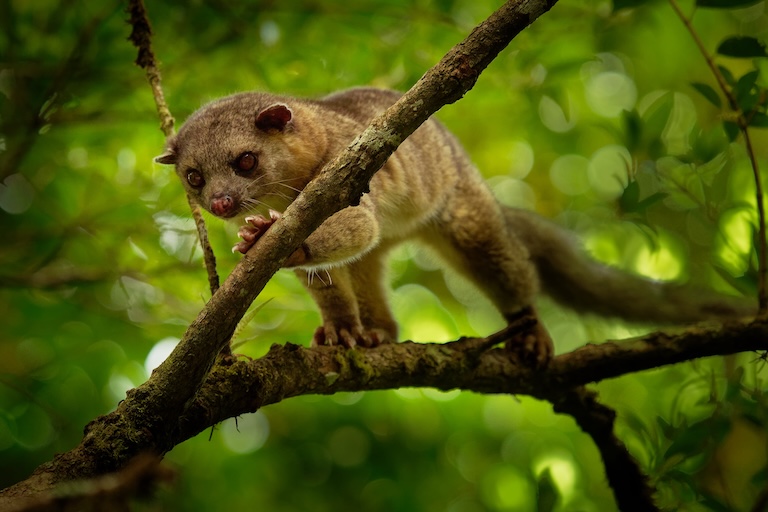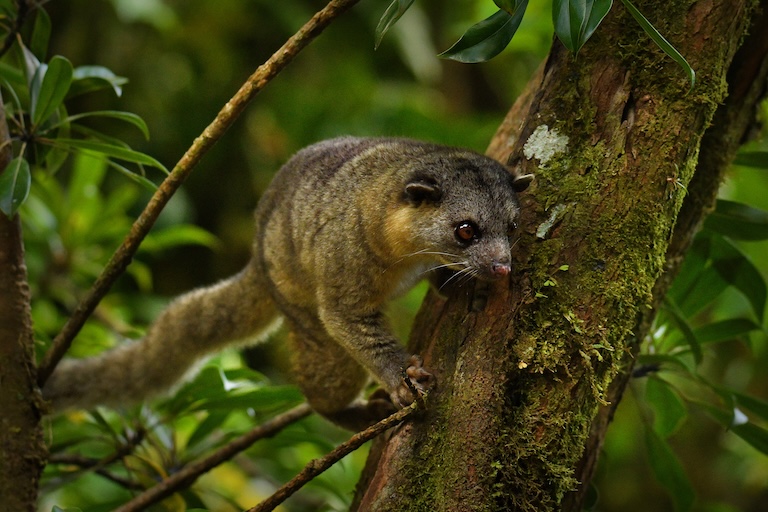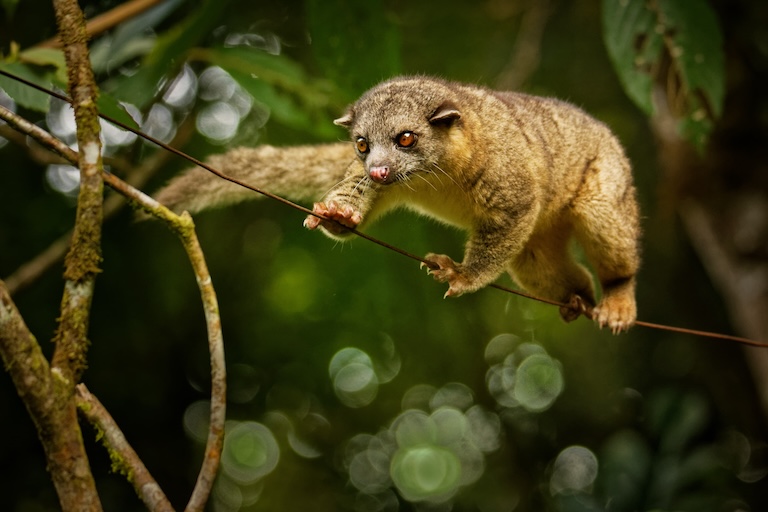Olingo Profile
Despite their rampant destruction, the forests of Central and South America are still teeming with hidden mysteries; species that have yet to be described and some of the largest animals still unknown to science.
Even zoos often don’t know what they’ve got, and for the poor Olingo, being poorly understood and so often mistaken for a kinkajou, this has created a bit of a rivalry in the cloud forests of the Americas.

Olingo Facts Overview
| Habitat: | Arboreal, montane rainforests |
| Location: | Central and South America |
| Lifespan: | Around 10 years in captivity |
| Size: | Up to 45cm (18 in) with a tail that’s slightly longer still |
| Weight: | The largest species weighs around 1.5 kg (3.3 lb) |
| Colour: | Usually plain, light to dark brown |
| Diet: | Mostly fruit, but also rodents, lizards, birds, eggs, insects, nectar |
| Predators: | Jaguarundi, ocelot, tayra, and several boas |
| Top Speed: | Not recorded |
| No. of Species: | Possibly 4 – 6 |
| Conservation Status: | 3 Least Concern, 1 Near Threatened (Olinguito, IUCN) |
Olingos are mysterious arboreal carnivores, appearing very much like kinkajous but being more related to coatis. And despite their order, they rarely eat meat at all, preferring fruit over flesh.
Nobody’s quite sure how many species there are, what their social lives are like, or really very much about them at all, but most of them appear to be doing okay so far, though, like all forest species, habitat destruction threatens to push them away before we even get a chance to find out.
Interesting Olingo Facts
1. They’re procyonids
The exact taxonomy of Olingos is rapidly becoming more detailed but it’s still got a ways to go before people can agree on what, exactly, they are.
Olingos are in the Carnivora order, along with cats, dogs, bears, and racoons. As it happens, racoons are the closest related to olingos of these examples, as members of the Procyonid family. But there are five other non-racoon genera in this family, one of which is the Olingo genus, Bassaricyon.
Beyond this, we get into a debate over how many species of Olingo there are. Some say one, others say five, and there are some real troublemakers who pick any of the numbers in between.
To make matters worse, the largest and most widespread Olingo species, the Northern Olingo, is often just called the Olingo, which – to the troublemakers, at least – is misleading.
And if this wasn’t complicated enough, Olingos look a lot like kinkajous, despite not being all that closely related.
So even zoos have been known to mislabel their animals. Genetic research suggests that the Olingo’s closest relatives are the coatis, despite their superficial resemblance to kinkajous, which is now thought to be a case of parallel evolution. 1

2. They’re still being discovered
But the matter is far from settled, as new species are still being discovered.
In 2013, a new species of Olingo was discovered, the olinguito. Making it the first new carnivoran to be discovered in the West in over 4 decades.
But there’s even more to the confusion. This group of mammals diverged from one another very recently in evolutionary terms, at around 3 to 3.5 million years back.
This makes them very closely related (for comparison, some estimates put our divergence from chimps back only 5 MYA, others as far back as 13 MYA). 2
3. They’re elusive
And further compounding our ignorance is the fact that olingos live in hard-to-reach places. Despite our constant efforts to encroach on their habitats with livestock and human development, we still haven’t managed to fully chop down the cloud forests of the montane regions of the Americas.
Even the Northern olingo – again, the largest and most widespread species – is thought to feed on fruit and nectar, but has very little else written about it with confidence.
4. They might be more social than we thought
Olingos were thought to be solitary, with a few exceptions made when they were spotted in pairs, but some old research that looks at their communication suggests they may be more social than they look.
Olingos studied in the wild in 2000 were reported uttering various noises at what was thought to be some kinkajous and in response to at least one other olingo. It appears this rabbit hole has not been explored any deeper since then. 3
5. They’re probably not super smart
One other thing that came out of the same research is the tendency for the same handful of olingos to get caught in traps. For tracking and sampling, the researchers would catch individuals, hoping to get a wide scope of data.
In one location, they caught olingos 28 times, but unfortunately it was one of the same four every time, one particularly simple male making up 10 of those captures, and another falling prey to the same trick 8 times.
Of course, there was the one male who was only caught once, and a female who was only caught two more times, so perhaps those two males are just the dim ones of the bunch. 4

6. Kinkajous hate them
While they were spotted barking at kinkajous, some other data emerged. It appears there’s some rivalry between the two genera of procyonid here.
This might have something to do with the mislabelling issue in zoos creating some sense of injustice among the community, but it’s more likely to relate to resource competition.
It’s no coincidence that the two animals look alike – they both exploit similar niches in the same environment. And this creates the potential for competition, as seen in the examples given of kinkajous chasing olingos out of trees each time they caught them in there.
The olingos would flee, then wait for the kinkajous to leave and sneak back in to finish the job.
But this wasn’t a universal rule – some reports show the two sharing trees in large groups together, likely when there’s plenty more food than either of them needs.
7. Habitat destruction is the main threat
The scarcity of data on these animals is a bit of a concern. As with everything that lives in the forests of the Americas, olingos are likely under imminent threat of destruction from deforestation.
Of the entire habitat range of the Northern Olingo, only 32% of it remains forested since 50 years ago. For the other species (if they exist), the data is just too insufficient to make reasonable assessments.
Olingo Fact-File Summary
Scientific Classification
| Kingdom: | Animalia |
| Phylum: | Chordata |
| Class: | Mammalia |
| Order: | Carnivora |
| Family: | Procyonidae |
| Genus: | Bassaricyon |
| Species: | B. gabbii |
Fact Sources & References
- Kristofer M Helgen (2013), “Taxonomic revision of the olingos (Bassaricyon), with description of a new species, the Olinguito”, PubMed Central.
- News Staff (2014), “Top 10 New Species of 2013 Announced”, Sci News.
- “Northern Olingo”, IUCN Red List.
- KAYS, R. W. (2000), “The behavior and ecology of olingos (Bassaricyon gabbii) and their competition with kinkajous (Potosflavus) in central Panama”, Sci Hub.
